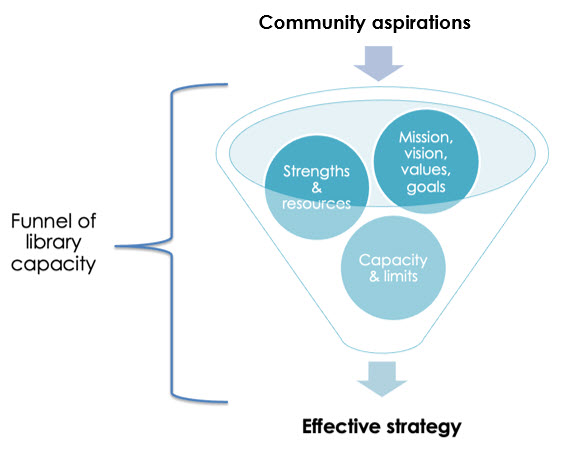Align library services with community aspirations

The most successful library services are often those that help the community meet its aspirations while also honoring the unique purpose of the library. But balancing the community’s goals and the library’s scope is not always an easy task. When I teach library workers how to co-create services with their communities, these are the questions I hear most often. What if the community’s goals are much different than what we traditionally think of as a library issue? (And of course, they often are.) What if they have nothing to do with books, reading, or even education? How do we support the community and stay in scope?
This article is part of a series about co-creating library services with community. In the first blog, I provided an overview of co-creating with systematically excluded communities. The next article and webinar built on the concept of building authentic relationships from an asset-based perspective. Those pieces both emphasized the importance of listening to community goals and aspirations. This article covers what to do next: building alignment between community goals and the library’s scope.
Move from relationship to partnership
Finding alignment allows you to do a very important thing. It helps you determine the idea that you and your partners will work on together, also known as a co-created project. Taking this step begins to transform your relationship into a partnership. What’s the difference? A relationship, like a friendship, is ongoing. It has no fixed goals, no set deliverables, and no end date. A partnership, by contrast, is a defined project. It’s timebound with a beginning and an end. We develop a partnership for a specific purpose, to accomplish an explicitly stated shared goal. One relationship may lead to multiple partnerships, because partnerships come and go, but relationships can be sustained.
As you decide whether to combine a relationship and an idea into a partnership, you will want to consider not just what you want to accomplish, but how you will work together to get there. Because partnerships and relationships are different, they need different supports to succeed. Like a strong relationship, a good partnership requires shared values. And these values inform how you approach the work and how you understand what it means to be successful.
Unlike a relationship, a partnership requires clearly defined shared goals. What do you want to accomplish for your organization and for those you serve? Additionally, partnerships need mutual benefit and mutual accountability. Co-creative partners need to have a plan to share the workload, the decision-making power, and responsibility for the outcomes. Maintaining this balance in the face of complex and inevitably changing circumstances requires clear, open, and thoughtful communication.
The alignment funnel

You’ve determined that you have the right partners at the table and you know what they care about. But how do you establish what services to develop together? Once you understand some of the key aspirations of the community you want to engage, you can develop an effective way to frame your partnership by passing those goals through what I call the “funnel of library capacity.”
In short, you begin with community aspirations. Then you unearth a way the library can play a role in supporting those aspirations through the lenses of its guiding principles, strengths, and available resources. The result—the intersection of community aspirations and library scope—is an effective strategy or direction.
The “funnel of library capacity” moves us through three layers, from the broadest to the narrowest. First, consider the library’s core principles. Its mission, vision, and values. What aspect(s) of the community’s goal(s) are related to the library’s guiding statements? At a high level, where can you find philosophical alignment between what the community wants and what the library strives to do and be?
Next, move to the level of goals. There are many things that a library could do within the scope of its mission; but for most libraries, trying to do them all at once would result in stretched resources and shallow impact. You can turn to your organization’s strategic plan or annual goals to tell you what your specific library is focused on doing at this moment. Where is there alignment between the idea you are forming and the library’s goals? How can the library play a role in this partnership that supports a community aspiration and simultaneously furthers one or more of strategies?
Once you’ve determined alignment between the library’s high-level direction and the community’s aspirations, begin to think more concretely about how the library might contribute. Just as we approach our community by thinking about strengths and assets rather than needs and deficits, we can bring that same mindset to our organizations. What strengths and assets can we draw on to make our project successful? How might we best leverage the expertise, resources, spaces, and skills we already have?
The final lens is a reality check. How much capacity does the library have for this project? It would be possible to come up with a project that aligns with the library’s principles and goals and draws on its strengths but is simply too large to manage. How much time, effort, budget, and space can you realistically put in? What scope is really feasible for you?
If you can refine an idea through all these layers and emerge from the bottom of the funnel, the result should be a well-honed idea for a partnership that is relevant to the community, important to the library, and supported with the strengths and resources to succeed.
When it doesn’t work
What happens when you don’t emerge from the funnel excited about a clear, aligned idea? What if you get stuck part way or find the result uninspiring? Don’t worry—this is a good thing. You’ve learned that this partnership is not going to be the right way to invest your limited time and resources right now. If you don’t have strong alignment, it’s okay not to move forward. Not all relationships can or should result in a partnership. Continue to maintain the relationship, just without a shared project.
From relationship to partnership strategy and beyond
If you’ve been following along in the series, you’ve set the stage for co-creating with your community. First, you established authentic relationships. Then you shaped a strategically aligned partnership idea that builds on the library’s strengths and principles to benefit the community. You are now ready to start making things. The final article and webinar discuss how to go through the co-design process with your partners to create a meaningful impact for your community.
Dr. Audrey Barbakoff is the CEO of Co/Lab Capacity, which provides community-centered consulting and training for libraries and social good organizations.
Explore more community engagement resources
This article is part of a collection of resources and webinars created with Dr. Audrey Barbakoff on community engagement. Explore the full collection, including articles and webinar recordings, plus learner guides and related resources:
- Co-create authentically with your community (OCLC Next blog post): Explore co-creation as an effective diversity, equity, and inclusion strategy and learn three important elements of its approach.
- Easy as ABCD: Using asset-based community development as a lens for authentic relationship-building (article): Strong relationships are the foundation for any kind of shared work. Building trust and mutual understanding through respect for each other’s strengths and gifts using an asset-based community development (ABCD) approach is a great place to start.
- Building authentic relationships with underserved communities (webinar recording): Learn how to develop a plan for identifying, reaching, and building relationships with underserved communities.
- Co-creating library Services for transformative impact (webinar recording): Learn about the fundamentals of co-design and explore how to apply them in your library for wildly creative and deeply impactful programs and services.
Community engagement
Where do you go for inspiration? Invigorate your community engagement efforts with advice from library leaders.
